The global coffee market size accounted for USD 245.2 billion in 2024, grew to USD 256.29 billion in 2025 and is expected to be worth around USD 381.52 billion by 2034, registering a CAGR of 4.51% between 2024 and 2034. The Europe coffee market size is calculated at USD 90.48 billion in 2024 and is estimated to grow at a CAGR of 4.59% during the forecast period.
The global coffee market size is worth around USD 245.2 billion in 2024 and is anticipated to reach around USD 381.52 billion by 2034, growing at a CAGR of 4.51% from 2024 to 2034. The increasing adoption of coffee culture globally is leading to the coffee market. The expanding number of coffee shops is the major driver that has led to the adoption of the trend.
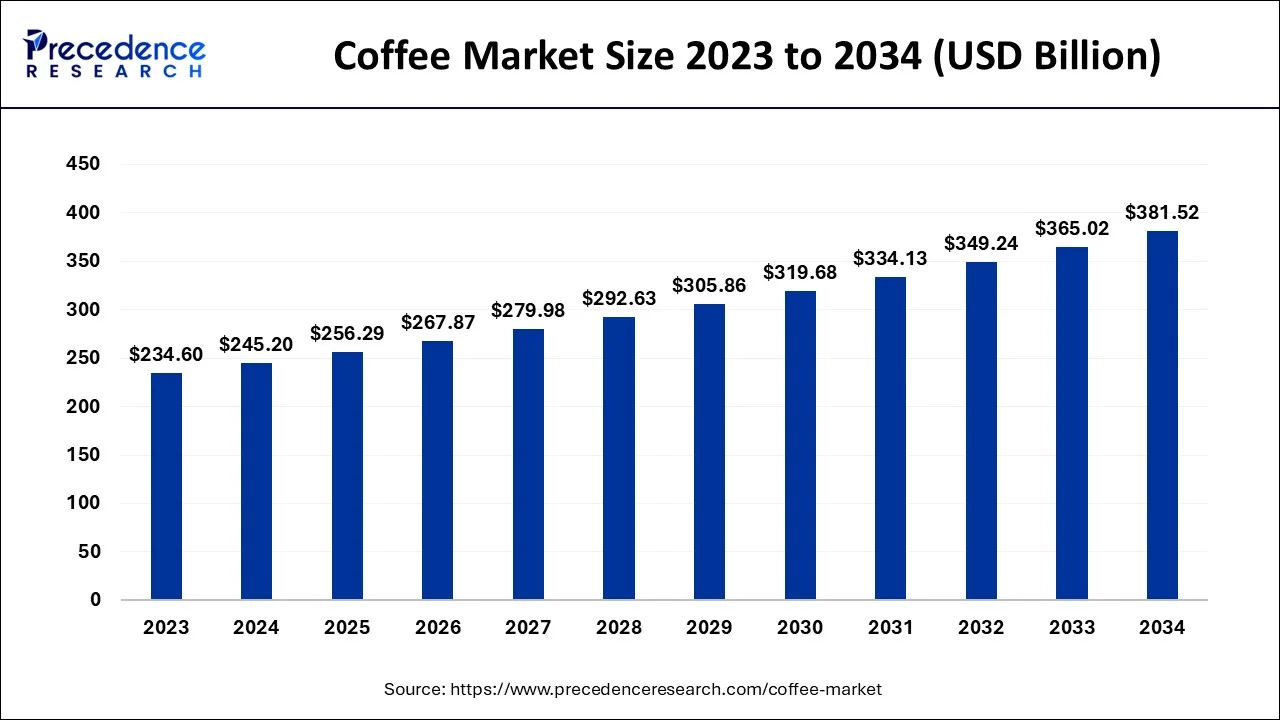
Europe dominated the global coffee market in 2023. A substantial majority of adults in Europe regularly consumes coffee. With a preference for high-quality coffees, manufacturers are shifting production towards specialty and premium coffees. There is a growing trend of increased consumption at specialty coffee shops in Western Europe, which primarily offer high-quality coffees. The UK coffee market has witnessed significant growth. Regional exporters regularly provide high-quality coffees and are expected to find these prospects particularly interesting.
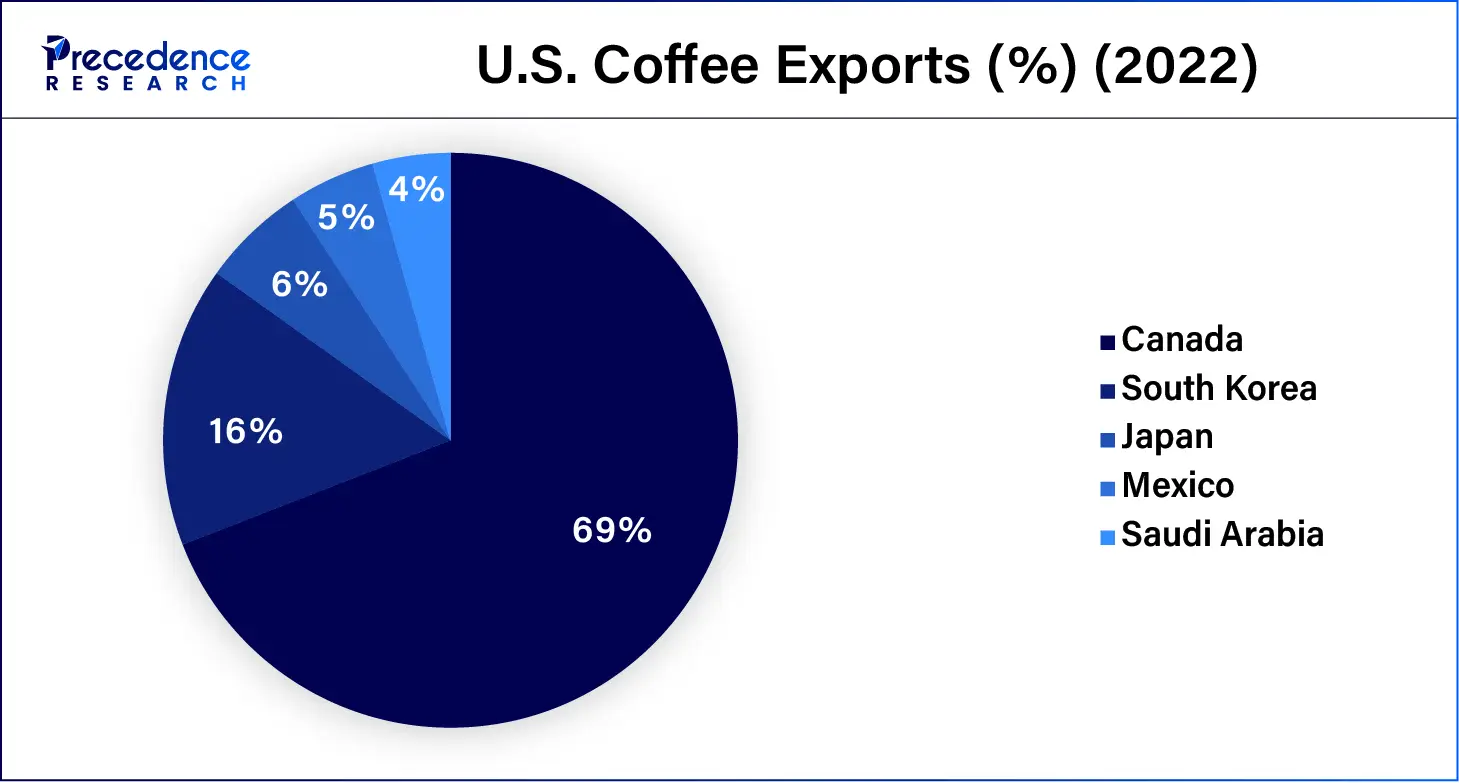
North America holds a significant share of the coffee market. The dominance of the region is attributed to the highest coffee-consuming countries, such as the United States and Canada. This rising demand has led to the increasing production of coffee-based beverages in the region. The changing lifestyle dynamics in the region have led to the rising preference for ready-to-go drinks that make coffee a preferable option due to its ingredients like caffeine. The United States is also one of the largest café market players, which makes coffee a dominant business in the region.
Asia Pacific is projected to grow at the fastest CAGR in the coffee market during the forecast period of 2024 to 2034. The growth of the region is attributed to the rapid urbanization in countries like India, China, and Japan. The individuals prefer coffee on a larger scale. The rise of e-commerce in developing countries is also expected to boost the growth of coffee in the upcoming years. The increasing tourism industry in Asian countries is also attracting companies who are investing heavily in coffee in the region.
Coffee refers to a beverage brewed from roasted seeds, also known as beans of the coffee plant. The beverage has gained significant popularity worldwide due to its health benefits, which include antioxidants that help in improving the functioning of the brain. The coffee market focuses on improving a wide range of activities, from the cultivation of beans to their consumption. The rising consumer preferences towards coffee are leading to the innovation of new types, flavors, and new methods, which helps in attracting more consumers.
How Can AI Help the Coffee Market Grow?
The growth of Artificial Intelligence (AI) has significantly helped towards the growth of the food and beverage industry. AI-based technologies have helped expand precision agriculture, which improves crop health and optimizes the whole agricultural process. AI also helps in predicting the health of the crops that maintain the coffee quality. The coffee market is witnessing significant growth due to the adoption of AI tools that help analyze datasets that include consumer preferences from all over the world.
| Report Coverage | Details |
| Market Size by 2034 | USD 381.52 Billion |
| Market Size in 2024 | USD 245.2 Billion |
| Market Size in 2025 | USD 256.29 Billion |
| Market Growth Rate from 2024 to 2034 | CAGR of 4.51% |
| Largest Market | Europe |
| Base Year | 2023 |
| Forecast Period | 2024 to 2034 |
| Segments Covered | Product, Nature, Distribution Channel, and Regions |
| Regions Covered | North America, Europe, Asia-Pacific, Latin America and Middle East & Africa |
Increasing coffee consumption among the youth
The changing lifestyle in urban areas is one of the major factors that has led to the increasing preference for coffee among millennials, and Generation Z. The urban lifestyle has led to the adoption of coffee in daily routines. The coffee market is mainly growing due to the increasing awareness regarding the health benefits of coffee that improves brain functioning. Additionally, the caffeine content in the coffee makes it preferable for use in hectic lifestyles. This has also created rapid demand for various coffee beverages in urban regions.
Expansion of café culture
The preference for outings has significantly increased in recent years, which helps enhance the social life of individuals. This has led to the expansion of coffee chains like Starbucks, Tim Hortons, Costa Coffee, and many others. These chains have a global presence, and they have played a significant role in contributing to the growth of the coffee market. The expansion of independent cafes has also gained significant popularity, and people have adopted the use of beverages like cold coffee and others. Additionally, the rise in tourism is also boosting the growth of the café culture, which is providing multiple business opportunities in the overall food and beverage industry.
Environmental concerns
The agriculture industry depends upon the weather and temperature, which is disturbed due to rising environmental concerns like climate change. Rapid changes in the weather disturb the whole agricultural process of coffee plants. Additionally, most of the coffee produced is from Ethiopia, Brazil, and Colombia, which could disturb the global supply chain of the coffee market. Additionally, the limited availability of water in some regions might affect the whole manufacturing process.
E-commerce growth
Rapid digitalization and rising internet penetration have led to the growth of e-commerce, where people prefer purchasing these food products online. These factors help the companies sell their coffee directly to the consumer, creating multiple opportunities in the coffee market. The rise of social media also helps in advertising the product, which could help increase its presence on social media. Additionally, the use of e-commerce eliminates geographical boundaries, which helps in selling coffee beverages online. The rising adoption of online food delivery applications is also expected to boost the demand for coffee brands.
Rising adoption of organic coffee
The increasing health trends have changed consumer preferences towards consuming healthy food options. This also relates to the use of organic ingredients that could help in attracting more consumers to the coffee market. This increases the opportunities in the agriculture sector, where governments aim to promote sustainable agriculture by prioritizing the use of organic ingredients that could help in preserving the environment. Many companies have started adopting clean label techniques.
The roasted segment marked its dominance in the coffee market in 2023. Roasted coffee refers to coffee beans that are heated to bring out the flavor and aroma, which are mostly consumed at homes and cafes. The dominance of the segment is attributed to the superior quality of the whole bean coffees, which drives the growth of the market. The rapid expansion of coffee culture in urban areas has majorly contributed to their huge demand. Roasted coffees can be used in different types, which allows the consumer demand to be fulfilled by using this product. Additionally, the rising preference for natural and organic coffee is leading to its demand globally.
The ready to drink segment is anticipated to grow at the fastest rate in the coffee market during the forecast period of 2024 to 2034. These coffees are often found in products like cans, bottles, or cartoons, which are available for immediate consumption. The growth of the segment is attributed to the rising demand for on-the-go consumption influenced by changing lifestyles. Many companies are introducing ready-made coffees that contain healthy ingredients that help attract health-conscious consumers. The rising product innovations like cold beverages and plant-based coffee options are expected to increase the demand for ready-to-go coffee drinks in the upcoming years.
The conventional segment stood the dominant in the coffee market in 2023. Conventional coffees are produced using farming methods that use fertilizers and pesticides. The dominance of the coffee market is attributed to its widespread use of conventional coffee over the past decades. These coffees are produced using methods that have fewer production costs, making them cost-efficient for the business, especially in developing regions. The rising demand for these coffees for commercial purposes is leading to the mass production of these coffees, making them popular in the market.
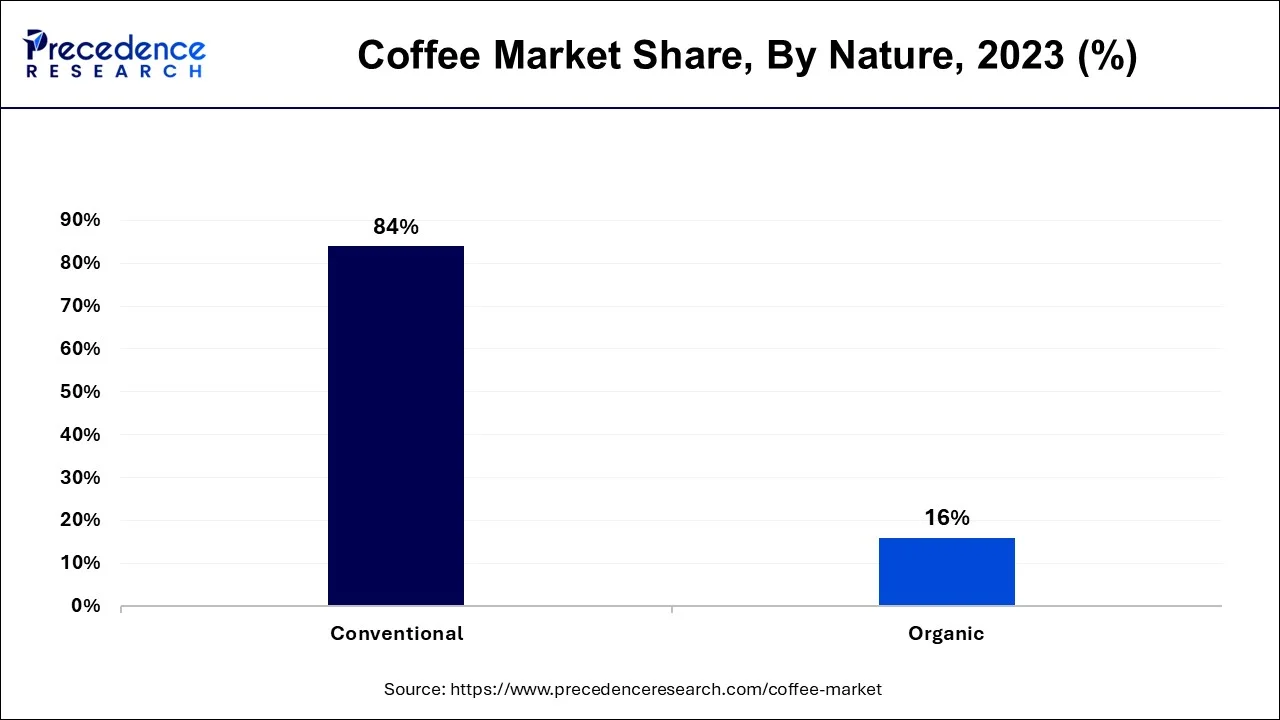
The organic segment is expected to register the fastest growth in the coffee market during the forecast period. These coffees are produced by eliminating the use of synthetic chemicals and organic farming practices. The growth of the segment is attributed to the increasing health consciousness among coffee consumers. Companies are adopting the production of these coffees, which is expected to boost the growth of the coffee market in the coming years. Many governments are also supporting organic farming practices by implementing laws and regulations. The growth of e-commerce is expected to help in increasing the supply chain of organic coffee products in the upcoming years.
The B2B segment led the global coffee market in 2023. The dominance of the segment is attributed to the widespread businesses like cafes, wholesalers, hotels, and others. The commercial industry has grown significantly, which has led to a massive demand for coffee. As a result, these businesses buy coffee in bulk, which makes them popular and demanding. Additionally, the rising partnerships among businesses are also major factors driving the growth of the coffee market.
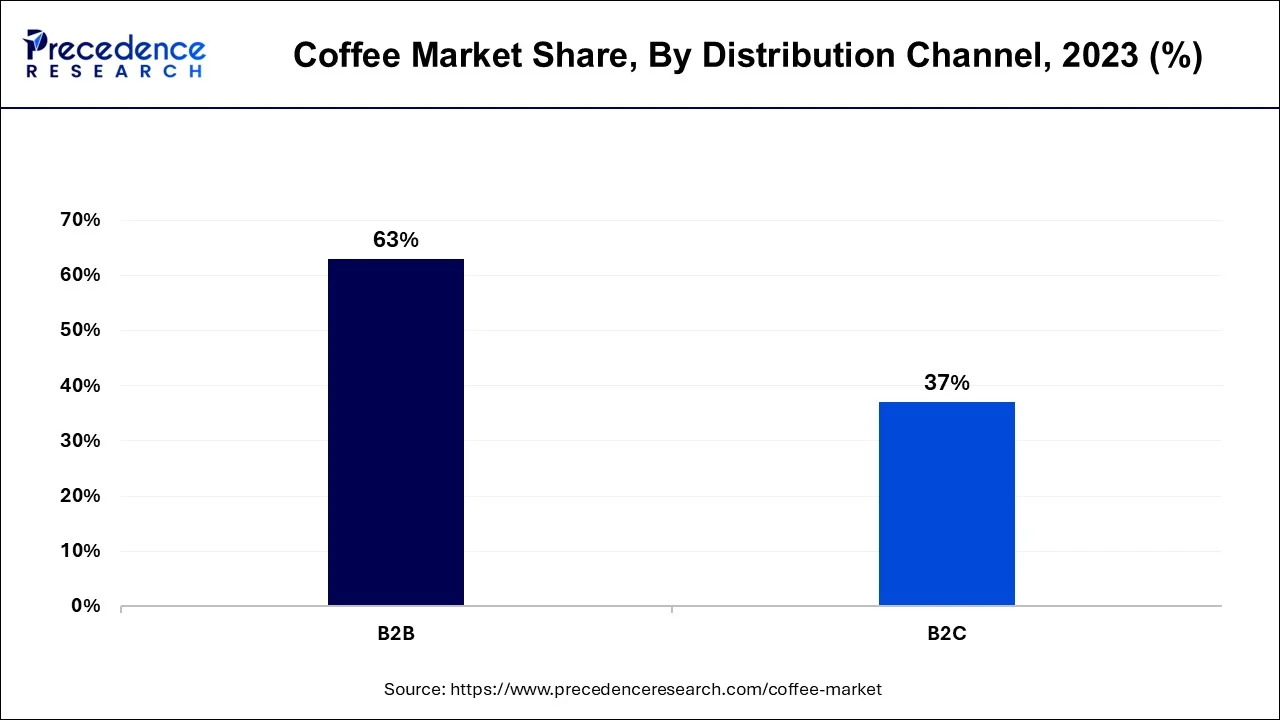
The B2C segment is expected to grow at the fastest CAGR in the coffee market during the forecast period. The rising supermarkets and the growth of the e-commerce platform are driving the growth of the coffee market. The rising coffee consumption among individuals has led to the demand for coffee which leads to its bulk purchasing by the stores and supermarkets.
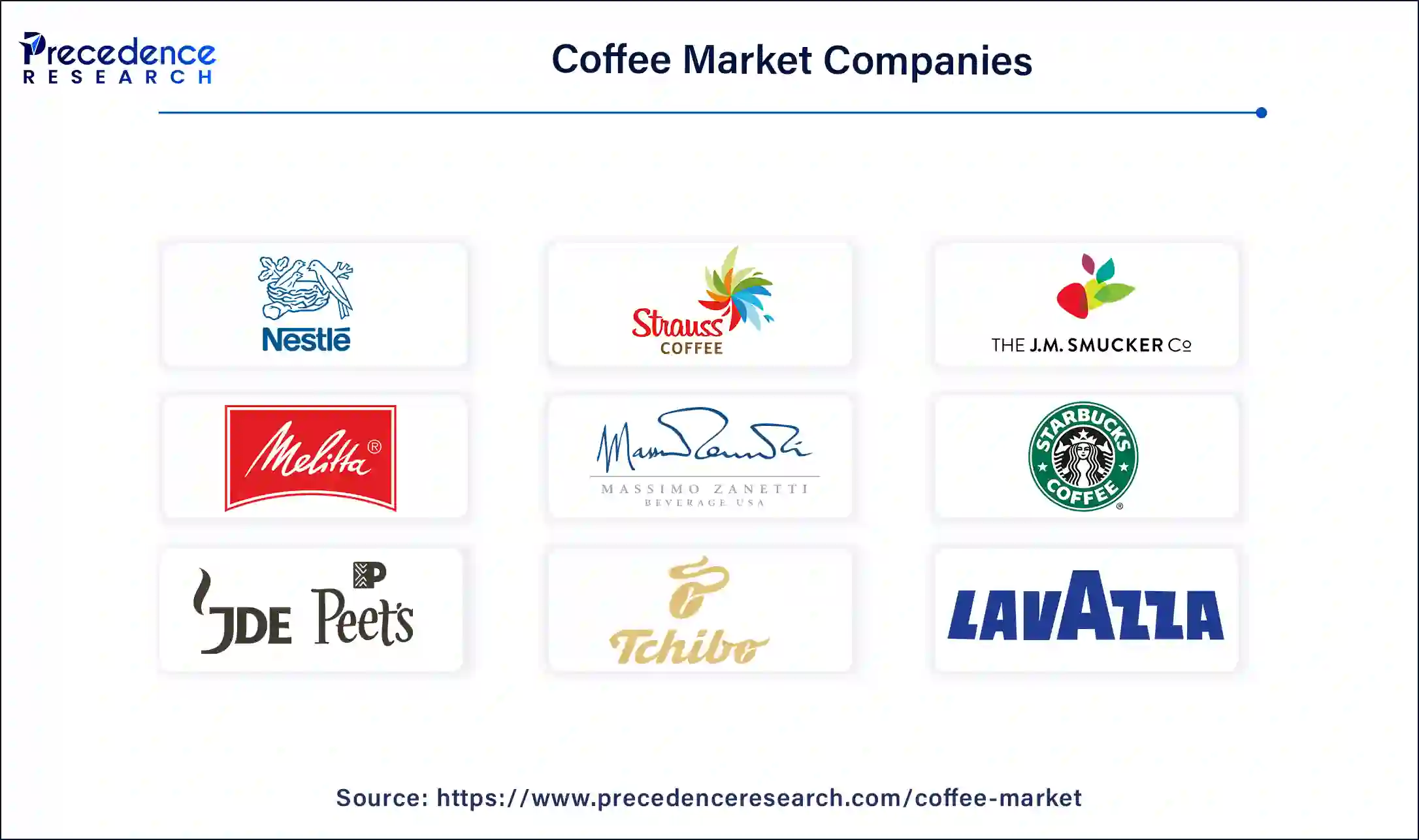
Segments Covered in the Report
By Product
By Nature
By Distribution Channel
By Geography
For inquiries regarding discounts, bulk purchases, or customization requests, please contact us at sales@precedenceresearch.com
No cookie-cutter, only authentic analysis – take the 1st step to become a Precedence Research client